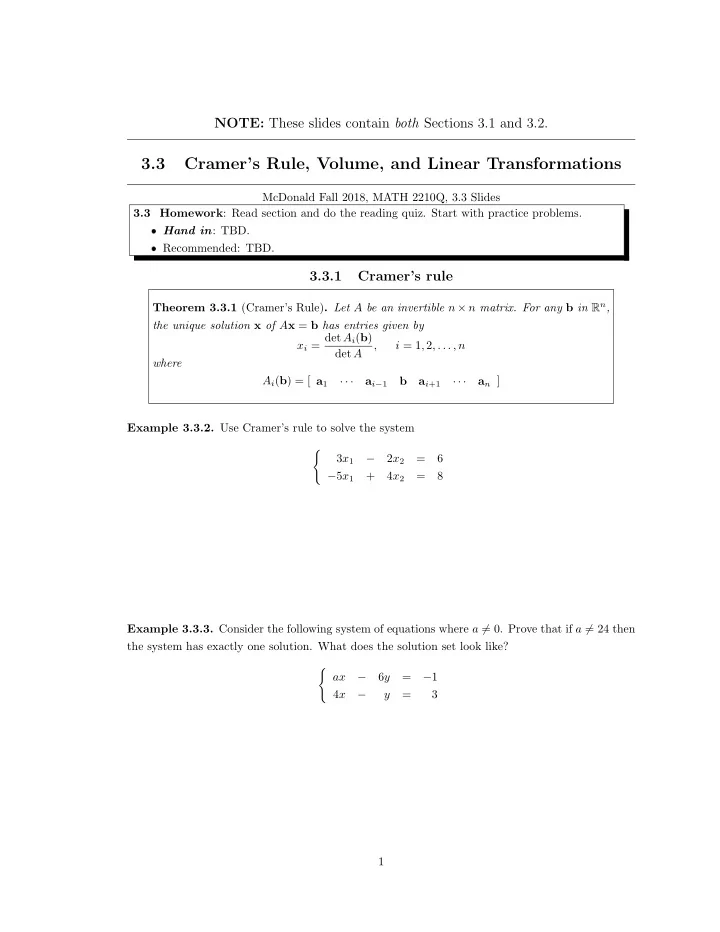

NOTE: These slides contain both Sections 3.1 and 3.2. 3.3 Cramer’s Rule, Volume, and Linear Transformations McDonald Fall 2018, MATH 2210Q, 3.3 Slides 3.3 Homework : Read section and do the reading quiz. Start with practice problems. ❼ Hand in : TBD. ❼ Recommended: TBD. 3.3.1 Cramer’s rule Theorem 3.3.1 (Cramer’s Rule) . Let A be an invertible n × n matrix. For any b in R n , the unique solution x of A x = b has entries given by x i = det A i ( b ) , i = 1 , 2 , . . . , n det A where A i ( b ) = [ a 1 · · · · · · a n ] a i − 1 b a i +1 Example 3.3.2. Use Cramer’s rule to solve the system � 3 x 1 − 2 x 2 = 6 − 5 x 1 + 4 x 2 = 8 Example 3.3.3. Consider the following system of equations where a � = 0. Prove that if a � = 24 then the system has exactly one solution. What does the solution set look like? � − 6 y = − 1 ax 4 x − = 3 y 1
Definition 3.3.4. The adjugate (or classical adjoint ) of A , is T C 11 C 12 · · · C 1 n C 11 C 21 · · · C n 1 C 21 C 22 · · · C 2 n C 12 C 22 · · · C n 2 adj( A ) = = . . . . . . . . . . . . . . . . . . . · · · · · · C n 1 C n 2 C nn C 1 n C 2 n C nn Where C ij = ( − 1) i + j det A ij . Theorem 3.3.5 (Inverse Formula) . Let A be an invertible n × n matrix. Then 1 A − 1 = det A adj A. Example 3.3.6. Find the inverse of the matrix 2 1 3 A = 1 − 1 1 1 4 − 2 Remark 3.3.7. This formula for the inverse is really useful for theoretical calculations, but in almost all cases, our algorithm of reducing to the identity is much more efficient. 2
3.3.2 Determinants as Area or Volume Theorem 3.3.8. If A is a 2 × 2 matrix, then the area of the parallelogram determined by the columns of A is | det A | . If A is a 3 × 3 matrix, then the volume of the parallelepiped determined by the columns of A is | det A | . Example 3.3.9. Calculate the area of the parallelogram with vertices (0 , 0), (1 , 2), (2 , 3) and (3 , 5). Example 3.3.10. Find the area of the parallelogram with vertices ( − 2 , − 2), (0 , 3), (4 , − 1) and (6 , 4) . 3
Example 3.3.11. Find the area of the parallelepiped with one vertex at the origin, and adjacent vertices (1 , 0 , − 1), (4 , 5 , 6), (7 , 3 , 9). Example 3.3.12. Find the area of the triangle with vertices (1 , 2), (4 , 3), and (3 , 5) . 4
3.3.3 Linear Transformations Theorem 3.3.13. Let T : R 2 → R 2 be the linear transformation determined by a 2 × 2 matrix A . If S is a parallelogram in R 2 , then { area of T ( S ) } = | det A | · { area of S } If T : R 3 → R 3 is a linear transformation determined by a 3 × 3 matrix A , and S is a parallelepiped in R 3 , then { volume of T ( S ) } = | det A | · { volume of S } � � � � 1 2 , and T : R 2 → R 2 Let S be the parallelogram determined by the vectors b 1 = and b 2 = 3 1 � � 1 2 be a linear transformation with standard matrix A = . Find the area of T ( S ). 0 5 5
3.3.4 Additional Notes and Problems 6
Recommend
More recommend